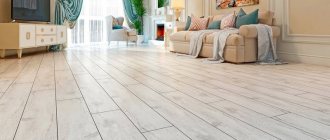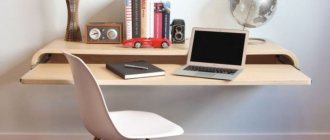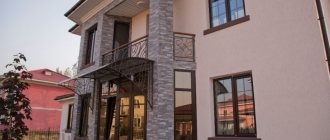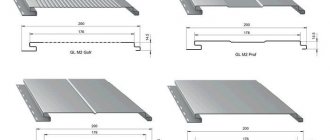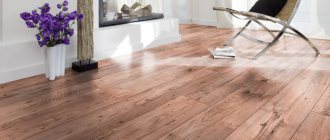10.05.2018
Laminate flooring has gained great popularity. It is highly practical, easy to operate, and attractive in appearance. This material is offered in different colors. This allows the buyer to choose the best option for their home. Laminate flooring from most manufacturers is standard in size and this makes installation much easier. This process does not require much effort and time.
Laminate length
The standard length varies in the range of 120-140 cm. You can buy boards whose length is no more than 184.5 cm. When laying long boards, problems often arise.
- Excessively small boards are inconvenient to lay. If there are a lot of them, the appearance will suffer.
- There is a need to perfectly level the work surface. There should be no tubercles or other defects.
- There is a need for constant cutting of the material. This does not have the best effect on the overall appearance.
Description of the laminate
Laminate successfully replaces solid wood parquet boards and consists of at least four tightly compressed layers.
Their name is as follows:
- stabilizing (lowest);
- carrier;
- decorative;
- protective.
Sometimes a layer of sound insulation is added below, which makes the room more comfortable and is especially important for the second floor and above. The thickest bearing layer is located in the middle. This is a wood-fiber board, the thickness of which largely determines the thermal insulation properties of the material. A lock is made on it, allowing the planks to be fastened together.
The protective lamination layer is responsible for wear resistance. Some manufacturers produce collections in which the coating is embossed, with even larger irregularities imitating the texture of wood.
Laminate thickness
The thicker the laminate, the more resistant the laminate is to fracture. Thick laminate is characterized by increased strength characteristics and solid resistance to dynamic and static loads. There will be no dents left on it even after prolonged use. However, it conducts heat poorly, so it is not recommended for laying “warm floors”. Characteristics of laminates of various thicknesses: from 10 mm - thick material, 6-7 mm - thin, 8 mm - the most popular laminate thickness.
Standard laminate sizes
Laminate boards may not always have the same dimensions, so when choosing material for flooring in your home or apartment, you should take this factor into account. Standard laminate sizes are usually calculated depending on three parameters - width, length and thickness. Therefore, it is worth first of all considering the size of the laminate depending on these three indicators. The values of all possible board sizes are collected in the table.
| Options | Minimum size, mm | Travel value, mm | Maximum size, mm |
| Length | 300-400 | 1260-1380 | 1845 |
| Width | 90 | 185-195 | 330 |
| Height (thickness) | 6 | 8 | 12 |
Square Rectangular Artistic Possible laminate sizes
Length
The length of laminated boards can have a fairly wide range. Usually it varies between 126 and 138 cm. Sometimes longer boards are found on sale; their length can reach up to 184.5 cm. Docks of this length are quite difficult to work with, because it is not always possible to lay long panels evenly.
What difficulties may arise when laying long panels:
- First of all, it is recommended to perfectly level the base of the floor. It is important that there is not a single bump or depression on the floor surface, otherwise the panels will be installed crookedly and there will be strong gaps between them;
- in small rooms it will be inconvenient to install panels that are too long; they may simply not fit the length or width of the room;
- When laying, you will have to frequently trim the material, which can negatively affect the overall appearance of the floor covering.
Length of laminate boards Dimensions of laminate boards
Width
Standard laminates come in different sizes depending on the width and can also be varied. Modern manufacturers of laminated material offer panels with several widths, namely:
- width sizes from 90 to 160 mm. With these parameters, narrow panels are produced that imitate the appearance of parquet; oak laminate is especially often produced with this size;
- With parameters from 185 to 195 mm, ordinary laminate boards are produced, which are the most popular product. In appearance it is an imitation of plank flooring;
- laminate board size from 330 mm is considered wide enough. When laid, they imitate ceramic floor tiles;
- up to 400 mm are wide laminate panels that imitate artistic parquet.
Of all these options, panels with width parameters from 185 to 200 mm are often used. They are the easiest to install, the coating looks beautiful and stylish. In addition, panels with these laminate sizes have an average price, high practicality, and versatility.
Thickness
Thickness is one of the important criteria for laminate boards. It is believed that the thicker the board, the more stable the panel parameters and the stronger the locking connections. In addition, the thickness size provides even more important qualities:
- strength, high resistance to static and dynamic loads. On boards with a large thickness, there are almost never scratches from furniture legs, they are not damaged by impacts, and are not deformed;
- Laminate with greater thickness conducts heat worse. Therefore, for arranging a warm floor covering, sheet material with a thickness of more than 8 mm is never used;
- Thick panels have slight deviations in size, so their installation will be easy and quick.
Possible laminate thickness
The standard size of laminate thickness is from 8 to 16 mm, but sometimes products with greater thickness are found.
Laminate with a thickness of 12 mm or more is considered thick, and with a thickness of 6-7 mm - thin. Material with thickness dimensions of 8 mm is considered popular. But a thickness of less than 6 mm is usually vinyl laminate, which is similar in structure to linoleum.
Features of choosing thickness and class
It is important to take into account not only the dimensions, but also the class of the laminate. Each class has specific operational characteristics. The wear resistance of the decorative top layer of laminate depends on the class.
32nd grade. It has a thickness of 7-12 mm. Suitable for installation in almost any room, including the bathroom or kitchen. The most suitable option for apartments, as well as offices and shops with a small number of visitors. In a home environment, such a product will last for 15 years. In public places it will last up to 5 years.
33rd grade. It has higher density and strength. Has a thickness of at least 8 mm. Characterized by increased abrasion resistance. Excellent heat retention and sound absorption. Suitable for creating a “warm floor”. He also:
- It is moisture resistant (some collections), making it suitable for kitchens, baths, restrooms and other similar rooms;
- suitable for institutions with high traffic (universities, clinics, offices and other institutions);
- can last up to 15 years in public spaces and 20-30 years in residential ones.
34th grade. It has a density of about 1000 kilograms per 1 cubic meter. 8-12 mm - panel thickness. Resistant to wear and can easily withstand even very heavy loads. Does not deteriorate even from increased cross-country ability. Excellently retains its original appearance. This is the best option for flooring in airports and other public places that are characterized by high traffic. In a living space it lasts up to 50 years.
Calculation rules
When choosing a laminate, take into account the size of the room. In standard rooms, medium-sized boards will look best. In small apartments it is worth using boards of reduced length and width.
Note! In the case of direct masonry, the formula applies: the area of the room plus 7% for trimming. Diagonal laying consumes more material. You need to add 10...15%.
The packaging usually indicates the area for which the number of planks in it is calculated. If you take the total area of the room in which you want to lay the laminate, and divide this number by the area on the package, you will get the required number of packages. Rounding is done upward.
Thus, in this case, the dimensions of the laminate board do not have a strong significance in the calculations. But they will affect you when you have to trim the boards located on the edge.
Size will also be of particular importance when installing flooring in non-standard rooms. In this case, it is necessary to complete the drawings in order to understand how to lay the laminate and what size is best to choose.
The edges of laminate boards can be straight or chamfered. The second option is preferable (although more expensive), since in this case the coating looks like it is made of real boards. Over time, small gaps will form at the joints, but if there is a chamfer, no one will notice them. At the same time, in high-quality products, the chamfer must be well protected from moisture.
Subtleties of choosing laminates of different sizes
The selection of laminate flooring for a living space must be approached with all seriousness. It must be of high quality and fully retain its characteristics throughout its entire service life. It is important to take the following information into account.
- The warranty period is the first thing you need to pay attention to. If the manufacturer does not provide a guarantee, then its product should be rejected.
- For rooms, a material with a thickness of at least 7 mm is recommended. The laminate should not break under the weight of various pieces of furniture.
- The boards must have a high-quality protective layer. In its absence, the product will quickly deteriorate. Recommended class - 32-34.
- You should avoid buying cheap panels.
- When deciding on a design, you need to take into account the style in which the space will be organized.
- Products should be ordered with a reserve of 5-15%. When laying, you can accidentally damage a couple of panels. Unopened packages can be returned to the store.
- You should save wisely. Personal financial capabilities are taken into account. There is economy, middle and premium class material.
- We have prepared for you a table of laminate sizes from different manufacturers; you can find it in this article.
More about classes
Modern technologies make it possible to produce laminate with fairly high wear resistance characteristics. This has led to classes 21, 22 and 23 becoming increasingly rare. Laminate intended for production has moved into residential and public spaces.
Class 31 is used in places where the load on the floor is not too large. They can cover any room in an apartment or private house. Often its thickness is 7 mm.
Class 32 laminate flooring of standard size is installed in hallways, kitchens and offices. Class 33 material is suitable for public places with high floor loads where there are many visitors.
Note! The thickness of class 33 laminate cannot be less than 8 mm.
And the highest 34th class is used where people pass en masse, heavy furniture and equipment are installed, for example in a gym, supermarket, hotel. It is usually classified as a commercial type. This laminate is 10-12 mm thick and sometimes has the largest longitudinal and transverse dimensions.
Of course, you can also lay class 34 laminate in the bedroom, but it will be quite expensive. If a 23rd or 31st class coating can cope with the load for decades, why pay more?
Non-standard solutions
The vinyl base material has non-standard dimensions. It is characterized by increased flexibility, withstands moisture well, does not crack, and does not lose its original shape under the influence of various external factors. Its other features include the following:
- increased strength (excellently withstands increased loads);
- long service life (minimum 20 years);
- environmental safety (has antistatic qualities);
- increased heat and sound insulation.
Looking for the best flooring for your living room? Laminate will be the best choice for you. It lasts a long time, does not cause problems throughout its entire service life, and always looks great. The range of such coverage is huge. For a room of any purpose, you can choose a suitable solution.
VIEW FULL LAMINATE CATALOG
Laminate characteristics
Like other materials, laminate has parameters that affect its performance characteristics and ease of installation. The number of boards in the package depends on the size.
Coating characteristics:
- thickness;
- length;
- width.
Important! It is generally accepted that the thicker the laminate, the stronger it is. However, it is not. It all depends on the materials used - high-quality panels are based on a high-strength slab.
Manufacturers do not adhere to uniform standards. Therefore, boards have completely different dimensions.
Laminate
The number of planks in the package also varies:
- 5 items;
- 10 pieces;
- 8 pieces is the most common packaging option.
However, focusing on the number of lamellas is wrong. The main thing is to take into account the total area of the lamellas in one package. When purchasing, it is recommended to round the quadrature up. After all, it is unknown how many strips will be needed for trimming. The excess material will be useful later for replacing damaged strips.
Length
When developing products, the manufacturer takes into account all sorts of nuances. The length of the laminate matters not only from a design point of view, but also from the point of view of ease of working with it. Too long boards complicate installation and transportation work, as they are heavy and bulky. And short ones can tire the master even faster, since it is necessary to perform significantly more actions during installation.
These two extremes must be taken into account, since many masters increase the cost of their services for this.
Companies involved in development and production have taken such points into account. Therefore, the dimensions of the laminate, or rather the length, varies in 90% of manufactured products within the range of 1200-1300 mm. This format is optimal in most cases:
- Fits perfectly in most apartment sizes
- Easy to work with
- Can be transported in your own car
- The packages are not heavy or bulky, which makes it easier to get to the apartment
But, as with everything, there are exceptions in this case too. For example, laminate “Berry Alloc” collection “Grandioso” in it the size of the boards is 2003 mm x 209 mm. Ideal for large rooms.
Its exact opposite is the “Biela” laminate, the “Koruna” collection, dies measuring 606 mm x 101 mm
Width
The width determines what decor will be on the floor. Thanks to digital photo printing technology, laminate looks like real wood or tile. At the same time, any wooden coverings can be imitated:
- Plank floor
- Piece parquet laid in staggered patterns, herringbone, squares, etc.
- Modular parquet
In each case, the width of the board is different. The most common size ranges are:
- 120-140 mm
- 170-200 mm
- 400 mm - typical for laminate under modular parquet
Laminate Versailles
Standard laminate width
The most popular laminate sheets of class 32 or 33 have a width of 193 mm - this is a standard that is determined by international and national documents (in Russia GOST 32304). Manufacturers regularly deviate from this figure: versions of smaller and larger widths can be found in the collections of all well-known factories.
Laminate flooring with a width of 185–193–243 mm most often imitates wood texture. These can be noble types of wood (oak, walnut) or more common trees (ash, maple). The speed of laying a standard floor covering remains average - this is due to the significant number of joints and the need to adjust the boards to the size of the room.
Medium-width laminate boards are convenient for creating an original pattern on the floor: herringbone, laying planks diagonally, and decorating rooms with radial or broken wall contours. The dimensions of such elements allow manufacturers to place an expressive pattern on their surface, which can highlight the design of individual parts of the interior decor: furniture, armchairs, floor lamps, curtains.
The average width of the parquet board is suitable for those who are planning to lay the flooring themselves, but do not have the relevant experience. Intermediate size planks are easy to mark and cut, lay and fix on the floor. They are not very demanding on the skills of the craftsmen, allowing you to hide minor marks of cutting or fitting in place. One person can handle laying such a coating in a standard room in 6–7 hours; if you have an assistant, the work will speed up by 1.5–2 times.
The economical consumption of intermediate-sized elements can be a significant argument when planning repairs. Panels of small and large widths provide significant waste of material when cutting it. In the first case, you have to cut a large number of planks, in the second, you have to remove a significant part of the board.
A medium-sized laminate requires an additional 5-7% of the room area during installation, a narrow one - 4-5% (but more labor costs for cutting and installation), and a wide one - up to 15%. This difference is fundamental when renovating several rooms or large office spaces.
Laminate floor care
Like any floor covering, laminate is subject to contamination during use. In order not to damage the material during the cleaning process, you need to know how to properly care for it. Here's what the manufacturers advise:
- Wax . Using liquid wax helps to increase the service life of lock joints, eliminate creaking floors and get rid of minor cosmetic defects.
- Vacuum cleaner . For cleaning, you can use washing models with wheels protected by rubber pads and brushes with a large number of bristles.
- Special pencil . Sellers never offer it, but if you see it, feel free to buy it. An indispensable item for eliminating scratches and small chips.
To clean laminate flooring from stubborn stains, you can use hot water and an ordinary rag. In some cases, you can add baby shampoo or vinegar to the water in a ratio of ¼ cup per liter.
Laminate laying technology
The problem with the size of the boards usually lies in the fact that the laminate is laid for a reason, but according to a certain technology, for the implementation of which a multilayer structure is created, consisting of the following elements:
- Laminated boards, which are a finishing coating;
- A substrate that levels out the smallest unevenness of the base;
- Vapor barrier layer;
- Concrete screed;
- Waterproofing layer;
- Basic concrete base.
A mistake made when choosing laminated boards can lead to a violation of the laying technology, in which case additional adjustment of the boards will be required - and this reason is quite serious, so the width and length of the laminate board must be correct from the very beginning.
Dependence of class on dimensions
Floor coverings are conventionally divided into classes. Numbering starts from 20, products in this category are considered homemade. Laminate of 30 classes is commercial, more reliable.
Material of classes 32 and 33 is often used; it differs:
- Reliability. The coating is made using hot soldering technology, which increases durability.
- Large thickness of wooden slabs (floor base) - at least 7–8 mm. Laminate is durable and can accommodate heavy furniture. The total thickness of one board is more than 1 cm.
- Great warranty from the manufacturer. For class 32 - at least 10 years, for class 33 - at least 25.
Reliability is ensured by increasing dimensions. Powerful locks require an increase in width, which increases the number of square meters in the package.
How to count
Flooring is sold in packs or according to the number of meters required.
First, calculate the surface area of the floor regardless of its geometry . Then niches, pillars, etc. are measured, the indicator is subtracted from the previously obtained square meters of the room. The boards in the niches are counted separately.
They choose a laminate (manufacturer, class, design, etc.), and calculate the area of one board in m2. The previously obtained value of the total area (in m2), the area of niches (also in m2) is divided by the area of the board. The result is the number of required boards (pieces). The value is rounded to the nearest larger whole number, 5–15% (3–5 pcs.) is added for cutting.
Flooring calculator:
Many manufacturers write on the packaging not the number of boards, but how many squares can be covered. Therefore, before purchasing, you need to inspect and study the label. Sometimes the package says the number of boards inside, not the area. In this case, pay attention to the area of one board.
Calculation of the amount of laminate
In order to calculate the required amount of material, it is necessary to carefully measure the area of the room, as well as the area of all niches in it. After this, it is necessary to determine the second important calculation parameter - the area of one laminate board. Considering the difference in sizes between different manufacturers, it is obvious that by the time of calculations it is necessary to decide on the brand and manufacturer of the laminate.
It should be remembered that laminate flooring is not 100 percent used during installation. The percentage of waste is believed to be between 5 and 15 percent. In practice, especially for those who are laying laminate flooring for the first time, we need to focus on a larger value.
Vinyl laminate sizes
Vinyl flooring products come in completely different sizes, this is due to their production technology and the PVC material itself.
The smallest vinyl tile has a size of 10x10mm; the maximum size of a vinyl sheet is produced within the length of a standard laminate, i.e. limited only by the capabilities of the equipment.
Thus, wide, short laminate sheets and especially square ones create the effect of a ceramic tile floor.
Long plank vinyl can have the same design as standard laminate, as well as other variations.
The most popular laminate sizes are calculated taking into account all ergonomic factors that influence the production of products, installation of coatings and room design.
That is why the size of a standard laminate varies within the range of length 1290mm, width 190mm.
The thickness of the laminated board only affects the strength and wear resistance of the product.
Laminate marking
To understand the characteristics of the laminate in question and its features, just look at its markings displayed on the back of the board. There are various indicators:
- Sample class . This indicator makes it possible to select an instance for specific operating conditions (for example, class 32 is suitable for use in commercial premises with medium load).
- Type of connection of lamellas . The R-CLICK marking is often found, which indicates the possibility of reusing the boards, since no adhesives are used for this connection.
- Type of processing . The image of a plane on the back of the board indicates that visually the panel will imitate the corresponding processing.
- Additional elements . The V icon indicates the presence of a chamfer around the perimeter of the board, as a result of which a natural wood board is imitated (read: “What laminate with a chamfer looks like in the interior”).
- Board lifespan with proper use.
Before choosing a laminate, you need to carefully consider all possible characteristics and know which option is required for a particular case. In addition, it is worth remembering that the cost of identical samples on the market may vary, so it is better to give preference to products from a well-established company.
Nuances of choosing panels
When choosing laminate flooring, you need to take into account many small, but by no means minor, details. Thus, the thickness of the board affects not only the mechanical strength of the lamellas. The thicker the coating, the fewer panels in the package, which must be taken into account when calculating the amount of material for repair. It is necessary to keep in mind the room itself where the coating will be laid:
- geometric dimensions;
- wall length ratio;
- illumination;
- configuration of light sources.
In addition, it is necessary to consider how the color and texture of the laminate will harmonize with the design of the room, doors, and furniture. This is one of the most important decisions when choosing a coating. After all, if the material does not visually fit into the interior of the apartment, then none of its positive qualities will correct this impression.
Next, you need to evaluate the load that the laminate will experience: what is the average expected traffic, whether heavy furniture or equipment will be installed. This will allow you to select the required coating class.
Extreme laminate inspection
At the third stage, it is determined which manufacturers’ material will be used. Here the most optimal combination of price and quality is taken into account.
Finally, at the final stage, the amount of laminate required for the work is calculated.
